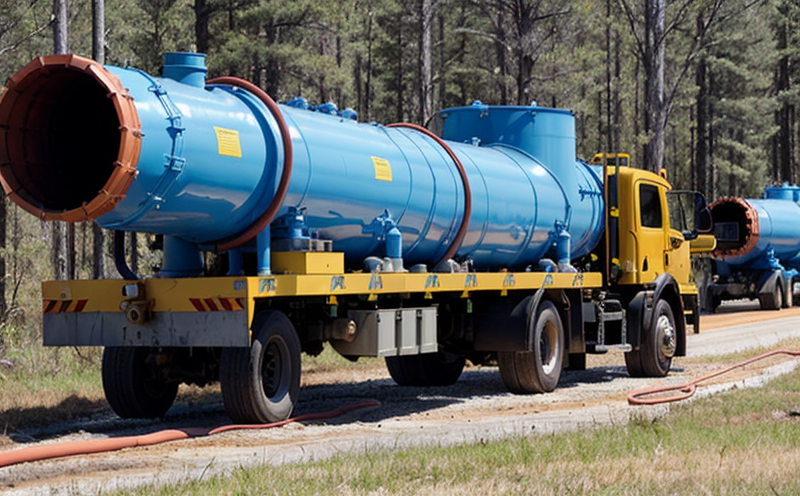EN 12327-2 Leak Tightness Testing in Gas Distribution Networks
The European standard EN 12327-2 is a widely recognized and essential guideline for ensuring the safety and reliability of natural gas distribution networks. This testing method is crucial for identifying any potential leaks, which can lead to significant health and environmental risks if not addressed promptly. Leak tightness testing ensures that the network maintains its integrity under various operating conditions, thereby safeguarding both human life and infrastructure.
The process involves a series of tests designed to identify minute leaks within the gas distribution system. These tests are conducted using specialized equipment that can detect even the slightest pressure drops or anomalies in the flow rate. The methodology typically includes pressurization of the pipeline segment under test, followed by holding this pressure for an extended period. During this time, any decrease in pressure indicates a leak.
EN 12327-2 specifies various test procedures tailored to different types and sizes of pipelines. For instance, small diameter lines may require simpler setups compared to larger trunklines which necessitate more complex arrangements due to higher flow rates and greater pressure variations. The testing parameters must be carefully selected based on the specific characteristics of each pipeline segment.
Before initiating any leak tightness test, it is imperative to follow strict preparation procedures. This includes isolating the section of the network to be tested from other parts of the system to prevent interference during the process. Additionally, ensuring that all connections are properly sealed and free from contaminants helps in obtaining accurate results.
Once prepared, the pipeline segment undergoes pressurization according to predefined standards set forth by EN 12327-2. The chosen pressure level depends on factors such as pipe material type, diameter, length, and expected operational conditions. After reaching the desired pressure, the system is held steady for a specified duration during which continuous monitoring takes place.
The monitoring phase involves using sophisticated sensors capable of detecting even minor fluctuations in pressure levels indicative of leaks. If no significant changes are observed after the holding period concludes, then the tested segment passes the leak tightness test. However, if there is evidence of reduced pressure or other anomalies, further investigation into the source of the issue becomes necessary.
Following successful completion of these tests, detailed reports summarizing all findings and results are generated for record-keeping purposes. These documents serve as proof that the pipeline network meets regulatory requirements regarding leak tightness. They also provide valuable insights into areas needing improvement or maintenance.
In summary, EN 12327-2 leak tightness testing plays a critical role in maintaining the safety and efficiency of natural gas distribution networks. By adhering strictly to prescribed procedures outlined in this standard, operators can ensure compliance with relevant regulations while simultaneously minimizing risks associated with leaks. This approach not only protects public health but also contributes significantly towards preserving valuable assets within utility infrastructure.
Scope and Methodology
The scope of EN 12327-2 leak tightness testing encompasses the entire natural gas distribution network, focusing particularly on identifying and addressing potential leaks. This standard applies to all types of pipelines used in delivering natural gas to consumers, including mainlines, branches, taps, and any other components that form part of the overall system.
- Mainline segments
- Branch connections
- Tap installations
- Valves and regulators
- Other auxiliary equipment integral to gas distribution
The methodology described in EN 12327-2 involves several key steps aimed at ensuring accurate detection of leaks. These include pressurization, holding periods, monitoring intervals, and recording procedures.
In the initial stage, each section of the pipeline is isolated from adjacent sections to minimize external influences on the test results. Once isolated, the selected segment undergoes pressurization using appropriate equipment capable of applying consistent pressure throughout the duration of the test.
Following pressurization, the system remains stable for an extended period, allowing any existing leaks to manifest themselves through observable decreases in pressure readings. During this holding phase, continuous monitoring is carried out at regular intervals using high-sensitivity instruments designed specifically for detecting minute changes in pressure levels.
If no significant variations are detected following completion of the holding period, the tested segment passes the leak tightness test successfully. Conversely, should any anomalies arise indicating possible leaks, further diagnostic measures may be required to pinpoint exact locations and causes.
The final step involves generating comprehensive reports documenting all aspects of the testing process along with observed outcomes. These documents serve multiple purposes including compliance verification, historical documentation, and future reference materials for preventive maintenance activities.
Eurolab Advantages
At Eurolab, we pride ourselves on providing top-tier services that meet or exceed industry standards. Our expertise in EN 12327-2 leak tightness testing sets us apart from competitors by offering unparalleled accuracy and reliability in identifying leaks within natural gas distribution networks.
- State-of-the-art facilities: We house cutting-edge equipment tailored specifically for conducting leak tightness tests according to EN 12327-2 guidelines. Our laboratories are equipped with advanced sensors, pressurization systems, and data acquisition tools that ensure precise measurements and reliable results.
- Certified personnel: Our team comprises highly qualified professionals who possess extensive experience in performing leak tightness tests across diverse applications within the power & utilities sector. They stay updated on latest developments in testing methodologies and adhere strictly to international standards such as EN 12327-2.
- Comprehensive service offerings: Beyond just executing leak tightness tests, Eurolab provides a full spectrum of related services including pre-test consultations, post-test analyses, and ongoing support throughout the entire project lifecycle. This holistic approach ensures that clients receive comprehensive solutions aligned with their specific needs.
We understand the importance of maintaining uninterrupted gas supply while adhering to strict safety protocols. That’s why our services are designed to minimize downtime and disruption during testing operations without compromising on quality or accuracy. By choosing Eurolab for your EN 12327-2 leak tightness testing requirements, you can rest assured knowing that best practices are being followed consistently across every aspect of the process.





